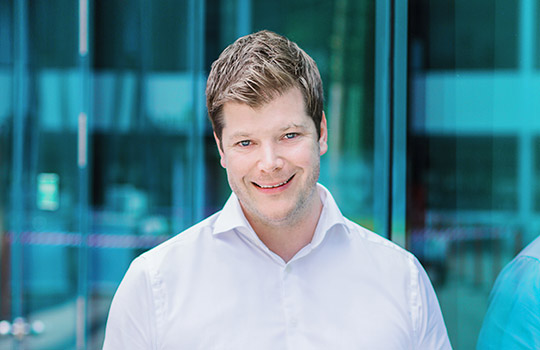Internet of Things for global applications
Global business models with small things
The Internet of Things can be used for more than just monitoring values at fixed locations; mobile applications also work from anywhere. This creates space for innovative new global business models – which also present their own challenges.
Text: Andreas Heer, Image: Adobe Stock,
The Internet of Things (IoT) is just starting to get rolling. And that offers a space in which to expand existing business models. Swiss coffee maker manufacturer Franke Kaffeemaschinen AG is embracing the Internet of Things as an opportunity to boost sales of coffee machines with additional services.
IoT is also a driver of innovation for a whole new set of data-driven business models. For example, ETH Zurich spin-off Nexxiot is developing entirely new business models for freight transport that rely fully on IoT. In the past, these approaches would have been unthinkable.
The heart of any IoT solution is a data and analytics platform that evaluates sensor data and delivers insights to users. Yet how does the data collected in various countries make its way on to the centralised data platform? This is just one of the challenges of global IoT solutions.
How to install small sensors on a grand scale?
A major challenge here involves the assembly. Global IoT solutions require thousands of sensors or devices to be installed over vast distances. Marcel Scheurer, CCO (Chief Customer Officer) at Nexxiot, is familiar with the problem: ‘It will take two to three years to equip a rail operator’s entire fleet.’ This is because installations or replacements can only be done when the rail wagon is idle or in the workshop.
The Nexxiot sensors are installed by the customer themselves in the rail wagons and containers. After that, a minimum lifetime of six years is guaranteed. Franke, in contrast, sells its coffee makers primarily in Europe, the US and Asia, relying on local distributors to handle sales and service.
“Only in a replicable setting can the customer benefit from economies of scale.”
Nils Weber, Franke
Providers that might currently be thinking of IoT solutions first need to examine the deployment scenarios and the lifecycle management of the sensors. Should they handle installation and maintenance themselves, leave it to the customer or employ a service provider? Which option is simplest?
Standardisation: a necessary evil
‘Our IoT solution is aimed at fleet customers who operate hundreds of coffee makers,’ says Nils Weber, Program Director Digital Innovation at Franke Kaffeemaschinen AG. ‘Only in a replicable setting can the customer benefit from the economies of scale.’
And to achieve this kind of scaling and make it pay off for providers and customers, IoT business models must be highly standardised. Otherwise, the effort is too great. ‘People often ask us whether we can adapt our services to local circumstances,’ says Weber, ‘but development would be much too expensive.’ Weber’s approach is therefore to focus on similarities rather than differences, since standardisation can also benefit the customer: ‘Our solution is universal,’ he says.

Nils Weber, Program Director Digital Innovation at Franke Kaffeemaschinen AG
Nexxiot faces a completely different challenge in terms of standardisation. Scheurer provides an illustrative example: ‘What does it mean, for example, for a container to have arrived? For railway operators, that might mean at the port or factory site. But for a carrier, this would be at the loading site.’ In other words, there needs to be a common language in the form of standards. Although European rail operators have created a basis with the Train Information System, the situation for shipping is much more complex. ‘There are numerous committees and different interests,’ says Scheurer. Nexxiot sits on certain standardisation committees, including the International Tank Container Organisation (ITCO) with more than 170 members. ‘It’s worth starting early,’ recommends Scheurer.

Marcel Scheurer, Chief Customer Officer at Nexxiot
“To get customers on board, we have to offer an all-inclusive service.”
Marcel Scheurer, Nexxiot
Where is all this new data taking us?
No comprehensive standards govern the storage of IoT data yet. All that is clear is that the information to be analysed is currently stored in the cloud, and Nexxiot and Franke use a centralised platform to do so. ‘Only through a “cloud first” approach will we be able to maintain a standard for data storage,’ says Weber. If data processing and storage are inconsistent, the rate of return for these services can no longer be guaranteed.
This is why both companies offer their clients the data platform as a service. Operators of coffee makers, for example, can access the usage data and configure the device displays centrally. Nexxiot customers have access to a dashboard with information on the location of rail wagons and containers, and the progress of a given transport operation. ‘We were only able to get customers on board by offering them an all-inclusive service,’ adds Scheurer.
This total package with measuring instruments and data analytics is necessary, since data integration into existing applications at the client end is challenging. In the best case scenario, the only thing missing is the interfaces. However, integration often fails due to the type of data, since the entry of transport and usage data into the business applications simply isn’t supported. For this reason, Nexxiot is focusing more on the processing and analysis of data, explains Scheurer: ‘We see ourselves as an enabler for optimized processes and complementary solutions from our customers to the shippers.’ Providers of IoT solutions must therefore consider exactly what their role is: data supplier for third-party systems or centralised information provider?
Connectivity restrictions
In order for information to flow at all, sensors need to be connected to the mobile network at the respective location. But this requires a provider that offers network access in all the desired countries. In western Europe this functions well, says Scheurer.
But it becomes more difficult in countries where mobile network access is expensive, meaning that connectivity starts to drive up costs. ‘This makes it more difficult for us to offer services for a flat fee,’ explains Scheurer. So it comes as no surprise that his dream is a global data flat rate. Until that happens, however, providers of global IoT solutions must factor the various costs of network access into their profitability calculations when preparing estimates.
And data transmission limitations can also have an impact on the business model. If data has to be processed locally for legal or regulatory reasons, this contradicts the idea of a centralised cloud platform and generates additional costs.
Still, at the end of the day, IoT solutions not only present technical challenges. Weber believes there is perhaps a less obvious obstacle; namely, the human factor: ‘Our solutions changing familiar processes,’ he says. ‘So change management is all the more important to ensure that everyone involved understands what is happening.’
What should companies remember when rolling out IoT solutions globally?
The white paper ‘Global or local – checklist for success’ addresses the eight key points.
Franke Kaffeemaschinen AG
Located in Aarburg near Olten (AG), the company belongs to the international Franke Group and sells coffee makers for commercial use through its network of distributors. The sensors installed in the devices measure usage data and send it to a centralised cloud platform, which allows the operators to determine, for example, whether the machines have been properly cleaned and how many drinks have been made. It can also control the display of the different drink options, as well as advertising on all coffee makers.
Nexxiot AG
Based in Zurich, Nexxiot is making the digitalisation of supply chains a reality. Sensors in rail wagons and containers monitor key metrics, such as temperature and vibration, and whether the containers have been opened. Supply chain operators not only know whether freight has been transported properly, but also where the containers and wagons are currently located. The ETH Zurich spin-off is expanding its product range; for example, in the area of shipping cargo. Recently, it announced that in 2020 it would digitalise the entire fleet of tank containers for the international logistics operator VTG.

Newsletter
Would you like to regularly receive interesting articles and whitepapers on current ICT topics?
More on the topic


